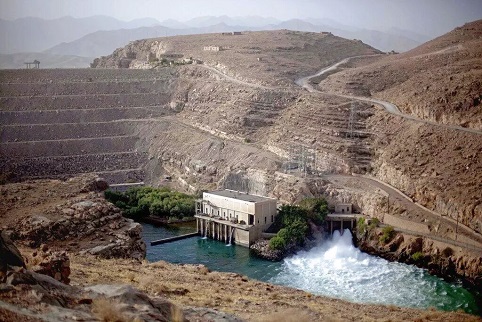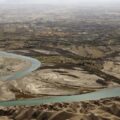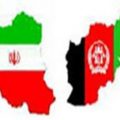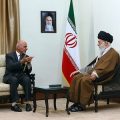
Title: Escalating Water Dispute Sparks Border Clash Between Iran and Afghan Taliban Forces
Date: June 10, 2023
Iranian and Afghan Taliban forces clashed on the border two weeks ago, resulting in two deaths and several wounded as tensions surrounding water rights continue to rise between Tehran and Kabul. The dispute between the two countries primarily revolves around the Helmand River, which plays a crucial role in Iran’s agricultural sector.
The turquoise waters of the Helmand River originate from the Hindu Kush mountains in east-central Afghanistan and flow southwest, spanning more than half the length of Afghanistan before reaching the Helmand swamps on the Iranian border. Iran heavily relies on this water source for irrigation in the southeastern province of Sistan-Baluchistan. However, Iran has accused Afghanistan of limiting the water supply, exacerbating tensions between the two nations.
In May, Tehran accused Kabul of violating a 1973 treaty that grants Iranians the right to utilize 22 cubic meters of water per second, with the possibility of an additional four cubic meters. Iran claims to receive only around 4 percent of the agreed-upon amount and issued a warning to the Taliban, demanding access to the Helmand waters.
Climate change and its impacts on the region’s water resources have further intensified the dispute. Iran, as a country with significant arid and semi-arid regions, is particularly vulnerable to desertification and prolonged droughts caused by climate change. Reduced rainfall and accelerating sequences of drought pose a significant risk to Iran’s agricultural regions, including Sistan and Baluchestan.
Jonathan Piron, a historian specializing in Iran at the Etopia research center in Brussels, emphasized the importance of the Helmand River for Iran’s agricultural development in Sistan and Baluchestan. The limited water supply from the river threatens the livelihoods of farmers in the region.
The recent border clash between Iranian and Afghan Taliban forces highlights the escalating tensions and belligerent stance taken by both countries. Accusations of firing first have been exchanged, further exacerbating the situation. Resolving the water dispute and finding a sustainable solution becomes crucial as water insecurity in the region continues to worsen due to climate change and increasing demand.
It is important for both Iran and Afghanistan to engage in diplomatic negotiations and explore cooperative water management strategies to ensure the fair sharing of water resources. Addressing the challenges posed by climate change and promoting sustainable water usage practices are essential steps towards reducing tensions and securing the water needs of both countries.
Iran’s Sistan and Baluchestan province is now home to vast expanses of dry land as prolonged droughts have accelerated the shrinking of Lake Hamoun – fed by the Helmand River – which used to be at the heart of the world’s seventh-largest wetlands.
Around the lake, wildlife and vegetation, agriculture and livestock, as well as villages have disappeared, leaving behind a desolate landscape.
To make things worse, the region is turning into a major source of dust storms due to the drop in vegetation cover.
The impact of dust storms on the already dry and poor soil in the region exacerbates the situation. Jonathan Piron, who has been conducting water research in Iran for several years, explains that these dust storms scrape the land, raising more dust, sand, and salt, and further damaging the agricultural areas located nearby. This highlights the vulnerability of the agricultural regions to environmental challenges, including the negative consequences of dust storms.
Water scarcity is also a pressing issue in Afghanistan, where it is vital for crop cultivation, especially considering the country’s food insecurity. Piron suggests that the Taliban’s interest in regaining control of the Helmand River is motivated by their desire to redistribute water resources to their own population, thereby asserting their legitimacy as rulers. Neglect of hydraulic infrastructure in Afghanistan during the decades of war has favored Iran in terms of accessing water resources, despite the water needs of Afghan communities.
In the past, the Afghan government accused Tehran of supporting armed groups in the regions surrounding Afghan dams, leading to instability. This accusation suggests that Iran’s support for these groups aimed to ensure the flow of water beyond the border, benefiting Iranian interests.
The water dispute between Iran and Afghanistan is multifaceted, encompassing historical agreements, climate change-induced water scarcity, and geopolitical factors. Resolving the conflict requires addressing these various aspects, engaging in diplomatic negotiations, and promoting sustainable water management practices to meet the needs of both countries’ populations.
In recent years, Afghanistan has taken steps to regain control of its hydraulic potential by accelerating the construction of hydroelectric dams and irrigation systems. One notable project is the Kamal Khan Dam, located on the border with Iran. After six decades of construction work, the dam was inaugurated in March 2021 on the Helmand River. This development signifies Afghanistan’s efforts to assert its sovereignty over water resources and enhance its water management capabilities.
Another significant dam, the Kajaki Dam, has also undergone major renovations and was recently completed. The Kajaki Dam has historically been a point of contention between Afghanistan and Iran. Originally built in the 1950s, it was abandoned during the Soviet invasion in 1979. After the fall of the Taliban in 2001, the United States played a role in getting the dam operational again through a comprehensive overhaul. Subsequently, in 2013, the Afghan government took charge of new construction work and enlisted the support of a Turkish company to complete the project.
These efforts by Afghanistan to develop its hydraulic infrastructure demonstrate its commitment to addressing water scarcity and harnessing its water resources for agricultural and energy purposes. However, it is important for Afghanistan and Iran to engage in diplomatic discussions and cooperation to manage shared water resources effectively and avoid further exacerbating tensions between the two countries.
Shaky relations
Tehran, however, is far from satisfied with the current situation as it continues to claim its right to water from Afghanistan.
“In reality, the Afghan leadership has not honoured its commitments under the [1973] treaty and has not offered the necessary cooperation to provide Iran with its legal water rights,” said the Iranian foreign ministry, adding that the situation has become “unacceptable”.
Iranian President Ebrahim Raisi said last month his government is determined to defend Iran’s water rights, threatening action against the Taliban if they fail to release more water. Tehran has rejected Kabul’s claim that lack of rainfall and a severe drought were responsible for the lack of water flowing to Iran.
Despite not recognizing the Taliban government, Iran has maintained friendly relations with its new neighbor, Afghanistan. When the exchange of fire occurred at the border in late May, Tehran and Kabul swiftly moved to deescalate the situation.
Abdul Nafy Takor, spokesman for the Taliban’s interior ministry, stated on the day of the incident that the situation was currently under control. He further emphasized that the Taliban government did not seek war with its neighbor, indicating their intention to avoid prolonged tensions and conflict.
Jonathan Piron acknowledges that neither party has an interest in prolonging tensions. This suggests that both Iran and the Taliban recognize the importance of maintaining stability and peaceful relations in the region. Diplomatic efforts and dialogue are crucial to finding a mutually beneficial resolution to the water dispute and preventing further conflicts along the border.
It is important for Iran and Afghanistan to continue engaging in dialogue, seeking diplomatic solutions, and exploring cooperative approaches to address water rights and management in the region. By working together, they can mitigate tensions and ensure the sustainable use of shared water resources for the benefit of both nations.









